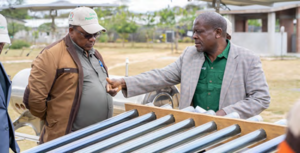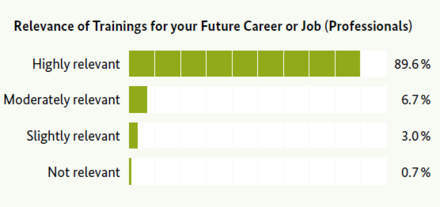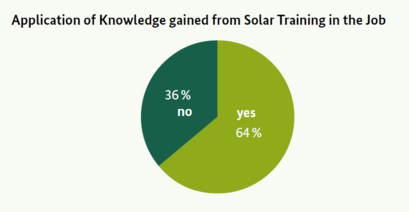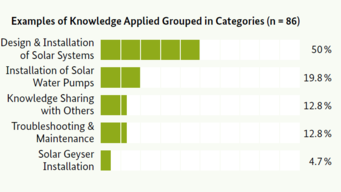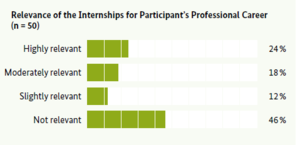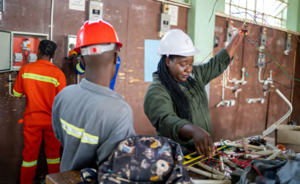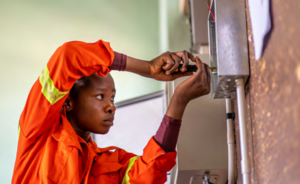Taking Solar Expert Training to the Next Level in Zambia
Taking Solar Expert Training to the Next Level in Zambia
Project Approach
In Zambia, the rate of access to electricity is around 47 %, with rates as low as 15 % in rural areas. Load shedding to prevent electricity system failure occurs regularly and leaves affected areas without on-grid electricity for up to 24 hours at a time. What is more, Zambia relies heavily on hydropower for its electricity production and therefore on the water levels of the Zambezi River and its tributaries. Droughts and irregular rainfall patterns can lead to reduced water levels, affecting the availability of water for power generation and making Zambia vulnerable to energy security issues. Climate change exacerbates these challenges.Second, led by the Technical Education, Vocational and Entrepreneurship Training Authority (TEVETA), two curricula and respective training materials are developed in a participatory process. The project cooperates with the four vocational training institutions (VTI) Saint Mawaggali Trades Training Institute (SMTTI) in Choma, the Livingstone Institute of Business and Engineering Studies (LIBES) in Livingstone, the Zambia College of Agriculture (ZCA) in Monze, and the Lusaka Business and Technical College (LBTC) in Lusaka. GBE provides these institutions with training equipment, demonstration systems and establishes regular exchange between teachers and solar companies. In a next step, the project provides the training of trainers in cooperation with the Fountain Gate Crafts and Trades School (FGCATS) and the University of Zambia. After that, GBE supports SIAZ in facilitating internships for trained solar professionals and in developing an awareness campaign. Particular emphasis is placed on the promotion of women in the energy sector.
Methodology of Data Collection
Data for this case study report was collected through a review of project documents, four qualitative interviews with representatives of the Ministry of Technology and Science (MoTS), the GBE project in Zambia, FGCATS, the Solar Industry Association of Zambia (SIAZ) as well as a quantitative survey among 281 professionals. A total of 134 professionals were randomly selected and participated in the survey. The gender distribution of 63 % men and 37 % women among the surveyed persons reflects the gender distribution of the beneficiaries reached in the GBE project. The case study was conducted between March and August 2023. At that time, a few project activities were still ongoing. Accordingly, the effects captured are not exhaustive.
Key Findings
Project Achievements
Based on the analysis and partner feedback, curricula were developed together with stakeholders from TVET and the private sector. The two curricula have an electrical (solar energy application installer) and an agricultural (solar energy application installer in agriculture) focus. The former addresses the target group of professionals who have a solid background in the field of electrics and the latter professionals from the agricultural value chain with more limited expertise. Both curricula were validated by a panel of experts and approved by TEVETA. Prior to delivering the courses in the training institutions, GBE supported the capacity building of the trainers, the development of the respective training materials, and financed the provision of training equipment to conduct the courses. The programme worked with the University of Zambia and FGCATS‘s Solar Academy, which trained 16 trainers from the VTIs. All trainers are now certified solar experts equipped with the theoretical knowledge and practical skills to deliver the solar courses to professionals and other interested parties.The GBE project also carried out the installation of solar demonstration systems with a capacity of 10 kW each in the four partner vocational schools as well as in the two institutions where the teacher training took place and handed over the solar systems to the partners. The systems are used in further training and serve to link theory and hands-on application. In sum, 16 trainers for the 4 VTIs and a total of 281 solar professionals, of which 105 were women (37 %), were trained during the course of the GBE project. 82 % of the capacitated professionals consider the received trainings relevant for their jobs, while only 18 % do not consider them relevant. Interestingly, almost all trained professionals regard the trainings important for their future career or job (see figure 1).Following the training measures, a total of 78 trained professionals were placed in internships at Zambian solar companies. In the growing but still small local solar industry, this is a considerable success in terms of numbers. In addition, two of the vocational schools independently placed 28 more skilled workers in internships. Completing a two-week internship enables the training participants to apply their acquired knowledge in a relevant professional context while establishing valuable contacts with solar companies. The solar association SIAZ handled the placement successfully. SIAZ was moreover supported in its organisational development with the objective to facilitate private sector cooperation with the VTIs and to promote long-term employment prospects in the solar industry.
Intermediate Impact
The conducted trainings have improved the capacities of the trained solar professionals. A large majority of 64 % have already applied the newly gained knowledge in the job (see figure 2). This can be considered a positive result, as not all qualified professionals are in employment. When asked to provide specific examples, the overwhelming majority of training participants provided examples from one of the five categories listed in figure 3 below. For example, one participant illustrated that she has “resized the cables, modules, and batteries of a [solar] system” and conducted a “site assessment before doing the installations.” Another participant stated that he has been “guiding farmers [on] how to install the solar panels and sizing the load against the solar energy needed.”The skills development measures for solar professionals have led to various positive effects. Of the 134 training participants 93 % perceive an improved performance in their job, 69 % have taken on new professional tasks, and 43 % report an increase in income. However, only 3 % have received a new position in their company and 1 % entered into a new job (see figure 4). A training participant confirmed that a “positive impact is that I am able to help people with challenges in their solar related installations.
All in all, the GBE project succeeded in increasing the number and quality of solar professionals in the labour market. Also, the trainers’ capacity was enhanced and the quality of teaching improved, especially in combination with the new training materials, the upgraded equipment, and the new solar demonstration systems at the VTIs. Thus, the project facilitated vocational training in the use of solar technology in rural Zambia.
Challenges in Project Implementation
While all interviewees considered the GBE project a success, some challenges evolved during the course of the project implementation. As illustrated above, a number of training participants did not consider the internships relevant for their professional career. For example, a training participant reported that once the internship started they were “only supposed to sell solar lights and not allowed to touch the solar panels” of the company, whereas others “were taken to an institution that was selling solar products like power banks” and “did not do anything they were taught” in the trainings. However, in these cases the interns were made aware of the commercial and/or marketing focus beforehand and even so they opted for them to improve their access to potential jobs.Additionally, even more training participants pointed to the “need to have internships” not only as a means “to fully practice”, but also to establish connections with companies, and to improve their employment prospects. The procurement process for the equipment at the VTIs and for the solar demonstration systems was considered very lengthy by a number of interviewees. As Zambia is a landlocked country and local supply options for the training equipment used by the VTIs are constrained, everything needs to be imported from other countries. Notwithstanding this, the GIZ procurement processes were regarded as tedious, mainly due to delays on the side of a supplier. For example, the sample demonstration system at FGCATS could not be used during the training of trainers and was only handed over to the institution in June 2023.
Moreover, one interviewee reported that a few equipment items delivered to one of the VTIs were sub-standard in terms of quality. To establish an open and continuous communication structure among all project partners was also considered challenging at the outset of the project. A GIZ interviewee noted that some partners did not communicate when they needed help in the beginning, whereas another interviewee from a partner institution felt at times not properly informed about the current status of the project.
Lessons Learned
The measures to achieve the relatively high rate of 37 % women participation, compared to other interventions that often struggle to reach 30 % participation quotas in technical fields, can be used as a showcase. Next to the general objective to promote women in the solar sector, the project had two female trainers, raised awareness to attract women in the VTIs (they now aim at 50 %), provided them with respective guidelines, and involved SIAZ to facilitate female participation. Pointed out by several interviewees, the crucial element was that the participating women received full sponsorship in terms of training fees and accommodation. A high-ranked official from the MoTS considered the achieved female participation “overwhelming and encouraging” for the further development of the sector.The provision of internships delivered mixed results and therefore offers ground for learning experiences. On the one hand, some participants were not satisfied with the relevance of the internships for their professional life, although the GBE project team managed expectations and communicated internship contents beforehand. Potentially, even clearer prior communication and agreements between the VTIs or SIAZ and the solar companies on the frame of the internship contents and the structured collection of feedback from the interns after their placement, could support the improvement of the internship quality further. Moreover, an interviewee elaborated that the two-week internships were too short and, hence, the industry exposure too little to understand the solar systems adequately in a practical way. In line with demands from the solar industry, it would be desirable to extend their duration. On the other hand, Zambia’s solar sector is in an emerging phase, the companies are small, and it presented a challenge to create enough internships opportunities for all training participants. It was only possible for less than half of the trained participants. As a newly established connection with a solar company might be just as valuable as demanding technical contents for interns, striking the balance between internship quantity and quality remains a case by case decision on the ground.
Closely related to the above, is the difficulty stated by many participants and reflected in the quantitative data to find a (new) job in the solar sector. To tackle this problem the GBE intervention included a full module on entrepreneurship in the trainings. An interviewee recommended to take this a step further by complementing the technical trainings with follow-up entrepreneurship promotion so that the “solar installers can operate on their own, especially regarding small solar home system” repair and maintenance. For example, an incubation facility for young entrepreneurs could be established, offering hands-on coaching in bookkeeping or marketing and providing low-cost desk spaces.
Another lesson learned is that procurement processes should be started at the earliest possible time to avoid delays in project implementation. Ideally, measures should be designed to guarantee a constant update of equipment (e.g. tools, software packages, etc.) for the VTIs so that they may move along with the progress in the sector and may keep providing an adequately skilled workforce. After initial challenges, the leadership of GBE in the steering committee was key to assure stakeholders’ buy-in, according to interviewees. This could be coupled with regular status updates or short monitoring briefs (e.g. in the form of a newsletter) to also keep stakeholders informed who are not part of the day-to-day implementation.
Sustainability of the Intervention
Both training curricula have been certified by TEVETA, are incorporated in the educational offer of the supported VTIs, and the trained lecturers are enabled to teach them, thereby assuring their sustainable use. Even the agriculture short-course may be integrated in longer term courses. Additionally, the partner VTIs have already been approached by further VTIs to have their lecturers also trained based on the new training curricula. Lastly, it has been agreed to use an existing review mechanism, enabling the public and private sector to collaboratively update the developed curricula.
The GBE project also coupled the provision of financial support and equipment for the VTIs with the requirement to develop a sustainability plan. For example, the demonstration systems in the 4 VTIs plus both teacher training facilities power water pumps, refrigeration rooms, computer rooms and lighting in some classrooms. They also save the vocational schools electricity, and thus money. This saved budget shall be used as an investment in the maintenance of the system as well as for the purchase of further training materials for solar in-service training. SIAZ and the partner VTIs have signed Memoranda of Understanding to ensure knowledge sharing and the continuation of internship placements beyond the project cycle. SIAZ as an association is not yet self-sustainable and is inquiring ways to generate sufficient finances. To this end, SIAZ has conducted a membership survey with an external consultant to determine services member companies would be willing to pay for and is hoping to develop a scheme of membership fees.
Also significant for the sustainability of the measures, the forthcoming GIZ successor project THRIVE will built on the majority of the measures developed by the GBE project. A joint operation planning workshop has already been conducted with the project partners. THRIVE will continue to work with three VTIs. Within the framework of THRIVE, the contents of the solar course developed by GBE will be integrated into the regular 2-year electrical engineering curriculum. In addition and since May 2023, the stakeholders in the field of vocational education and training for renewable energies have been better coordinated between the Ministry of Energy, the MoTS and the private sector within the framework of the so-called Off-Grid Task Force. This is intended to strengthen the complementarity of activities and the use of synergies beyond the individual project area.
Conclusion and Outlook
The GBE project successfully tackled the core problem of insufficient TVET provision for the use of solar technology in Zambian rural areas. It broadened its scope, depth, and practical orientation. GBE‘s intervention has facilitated and increased the quality and quantity of solar professionals in the sector. A MoTS official considered the GBE project “a very good starting point for the government to build on” because it brought in the solar energy “angle that was not there before.” In this sense, the project “was not really innovative but needed” and the Zambian government is already planning to roll out the developed curricula to other VTIs. Based on the GBE experiences, it is also considering to establish a centre of excellence as a role model for other VTIs to learn from (e.g. upskilling, re-skilling). Ultimately, THRIVE will support the further expansion of TVET for the use of solar technology in Zambia with its broadened scope.

